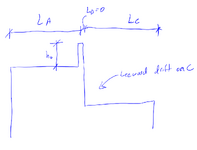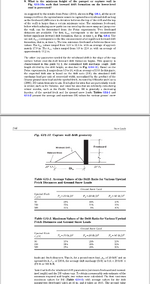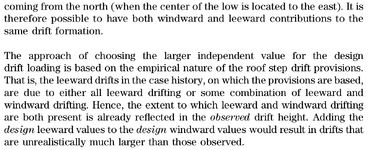RFreund
Structural
- Aug 14, 2010
- 1,884
There was an article in the March 2025 article of Structure Mag by O'Rourke titled Roof Snow Drift due to Ground Snow Load.
See here: https://www.structuremag.org/article/roof-snow-drifts-due-toground-snow/
This got me thinking about stepped roofs and what fetch distances should be used. In the article they say that ground snow won't contribute to roof drift until a drift "ramp" is created. They say that the windward drift at the ground has 100% trapping efficiency until a certain ramp height is reached. Then at that point, the ground snow load can be transported to the roof and will contribute to drift on the roof. They solve for what those upwind fetch distances are and provide a table (see below).
I find it a bit odd that they say windward drift has 100% trapping efficiency. In O'Rourke's Snow Loads Guide, he mentions that windward drifts are less efficient at trapping snow and that is why we use 0.75 x the drift height for windward drifts. Can anyone offer any thoughts on this seemingly contradictory information?
My next question is, can these ground fetch distances be used to determine what fetch distances should be used in the case of stepped roofs and parapets? Here are a couple common examples:
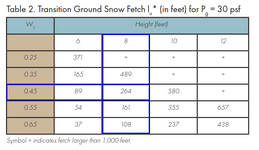
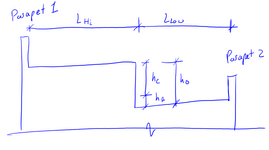
What is the windward fetch distance you should use for parapet 1? Let's say we have the following geometry:
L_Hi = 100'
L_Low = 150'
h_o = 8'
If I look at the table for ground snow fetch length, I would need a fetch length of 264'. Since the lower roof is less than that, the ramp does not form and thus all the snow on the lower roof is trapped at the windward drift. Therefore, my fetch length for parapet 1 = L_hi (100'). Is that correct?
For the fetch distance of parapet 2 I would use 0.75*L_hi + L_low per O'Rourke design guide recommendation.
Another case is show in the article. My question is what is the fetch distance for Roof C leeward drift?
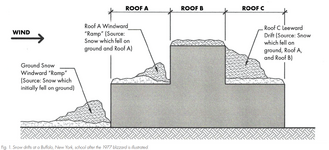
Similar to the previous argument, if the length of Roof A is less than the required fetch distance given in the table (264 feet), then the roof C leeward drift would only be the length of Roof B.
Having said that you can see that he comments that the roof C drift could be due to Roof A, B, and the ground snow. Any thoughts on this?
Thanks!
See here: https://www.structuremag.org/article/roof-snow-drifts-due-toground-snow/
This got me thinking about stepped roofs and what fetch distances should be used. In the article they say that ground snow won't contribute to roof drift until a drift "ramp" is created. They say that the windward drift at the ground has 100% trapping efficiency until a certain ramp height is reached. Then at that point, the ground snow load can be transported to the roof and will contribute to drift on the roof. They solve for what those upwind fetch distances are and provide a table (see below).
I find it a bit odd that they say windward drift has 100% trapping efficiency. In O'Rourke's Snow Loads Guide, he mentions that windward drifts are less efficient at trapping snow and that is why we use 0.75 x the drift height for windward drifts. Can anyone offer any thoughts on this seemingly contradictory information?
My next question is, can these ground fetch distances be used to determine what fetch distances should be used in the case of stepped roofs and parapets? Here are a couple common examples:


What is the windward fetch distance you should use for parapet 1? Let's say we have the following geometry:
L_Hi = 100'
L_Low = 150'
h_o = 8'
If I look at the table for ground snow fetch length, I would need a fetch length of 264'. Since the lower roof is less than that, the ramp does not form and thus all the snow on the lower roof is trapped at the windward drift. Therefore, my fetch length for parapet 1 = L_hi (100'). Is that correct?
For the fetch distance of parapet 2 I would use 0.75*L_hi + L_low per O'Rourke design guide recommendation.
Another case is show in the article. My question is what is the fetch distance for Roof C leeward drift?

Similar to the previous argument, if the length of Roof A is less than the required fetch distance given in the table (264 feet), then the roof C leeward drift would only be the length of Roof B.
Having said that you can see that he comments that the roof C drift could be due to Roof A, B, and the ground snow. Any thoughts on this?
Thanks!

